SHARING THE NORTH SHORE WITH BLACK BEARS
Black bears are a highly misunderstood species and are commonly misrepresented, consequently causing many people to have an exaggerated fear of them. In fact, black bears are calm and intelligent animals who are adapting to increased human and dog activity in areas where they live. Bears are part of our wider community but they are not domesticated. Calmly step away from bears and never approach them intentionally. It is normal to see bears during the daytime; they are not fearful of humans, but they aim to avoid close encounters with us. Bears rarely approach people with intent, however, do not expect a bear to run away from you or your dog – that wastes energy. Given the nature of where we live, bears often have no choice but to travel through neighbourhoods. When bears are close to homes, they are not seeking to hurt people, dogs or cats. They are looking for a safe place to avoid other bears, natural food, opportunities to supplement their natural diet, a quiet place to rest or are just passing through.
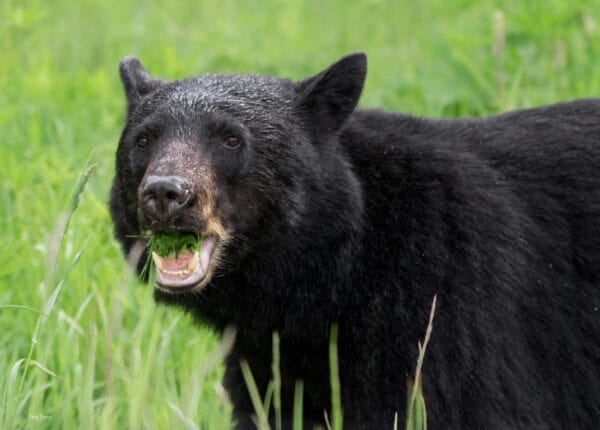
Bears can be found in almost any area on the North Shore, from the beach to the mountains and everywhere in between. To date, Lower Lonsdale and Central Lonsdale are the only communities where bears are rarely sighted. We are grateful to be supported by the District of North Vancouver, the District of West Vancouver, and the City of North Vancouver.
Bears are most active from late February to mid-December here. Mild winters and access to unnatural food from humans contributes to late winter activity. Male bears who continue to find sufficient calories may den for shorter periods over the winter. Some bears occasionally leave their den in search of unnatural food and bears who do not gain enough weight to enter dormancy remain active in an effort to survive. Be prepared to see a bear at any time of year on the trails, in neighbourhoods and at campsites. Late winter sightings in residential areas are increasing each year.
Healthy, dominant adult male bears typically occupy the best home ranges, living further away from people and often being more active at night. This forces bears who are vulnerable to them, such as females with cubs, juveniles, injured or older bears, to seek safety by being more active during the day. Those bears are also forced to live on the periphery of areas occupied by humans. Mother black bears are especially timid and choose to live closer to us in an attempt to keep her cubs safe. Her nature is to retreat from threats, but if you surprise her at close range, she may feel pressured to defend her family. Communicate to her that you are not a danger by using a calm tone, slowly distancing yourself and leaving the area. Moving bears from their home on the North Shore is not an option or a solution; vulnerable bears will always live closer to us. Every day, bears live in close proximity to us without incident and display their willingness to peacefully coexist with humans. If more people act on ways to share the North Shore with bears, we know we can be respectful neighbours. Black bears can live for 25 years or more. Sadly, bears that live closer to humans live significantly shorter lives. Many of our North Shore bears are killed before making it to adulthood. Help us to change the way we coexist with bears by learning more about these magnificent animals.
THE FOREST IS HOME
Black bears evolved in forested areas and are fast and agile tree climbers. Trees are their safe place; a black bear’s instinct is to retreat from confrontation by scaling a nearby tree. During the summer months, bears seek shade in the tree canopy and it is common to see bears in wild and residential fruit trees. Typically, a black bear will not climb down from a tree if people or pets are close by, they may also choose to wait until darkness. Mother black bears send their cubs into a tree to avoid encounters with humans, pets and wildlife. Climbing is one of the first and most important skills a mother teaches their 5-month-old cub when they emerge from the den they were born in. When cubs are in a tree, their mother may step away to forage or protect them by guarding the base of the tree. If you notice a bear in a tree, always calmly distance yourself. Standing at the base of the tree traps the bear, which adds further stress to their lives and can make them an easy target to be killed if they are in a human occupied area.
Bears travel along creeks and rivers in search of food. It is normal to see increased bear activity at lower elevations during the spring, with some bears expanding their range to higher elevations in the summer as snowmelt offers foraging opportunities for new growth. During winter months, trees provide safety and shelter. Bears enter a state of dormancy called torpor around mid-late December, but not a deep sleep, which serves them well should they need to protect themselves. Their heart and respiratory rates significantly reduce, but their body temperature drops only slightly. Impressively, they do not eat, drink, urinate or defecate while denning. North Shore black bears are known to den at the hollow base of trees or under windfall. In an effort to create distance from dominant males, vulnerable young and injured bears may den close to the community or trails.
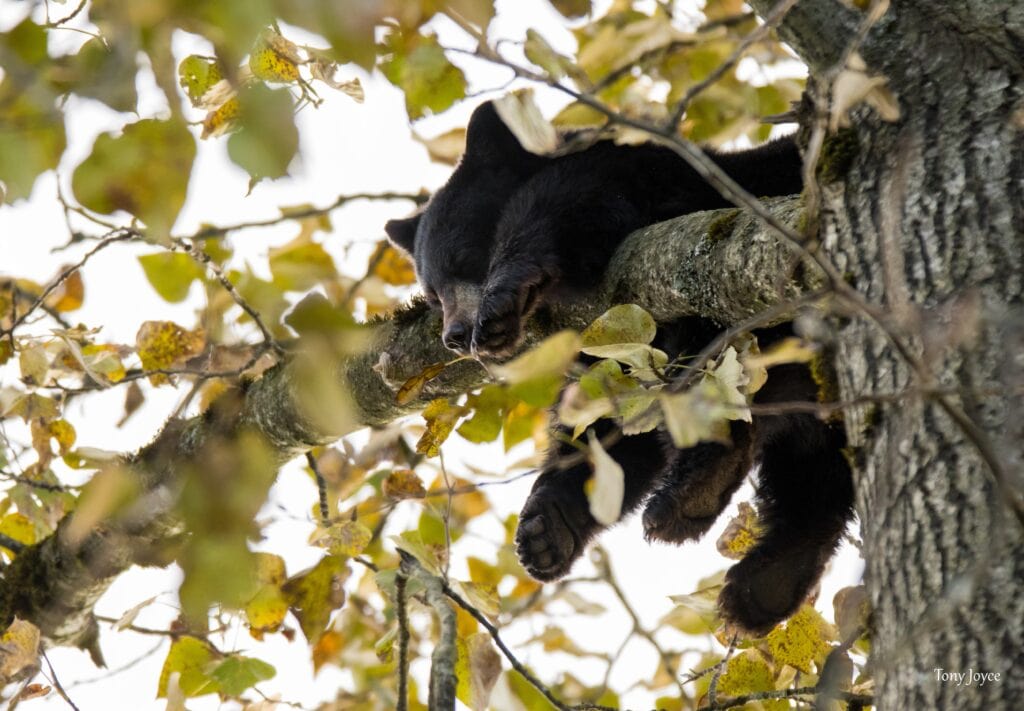
NSBBS/Tony Joyce
BEARS AND WATER
You could see a bear at the beach or even in the ocean. Bears enjoy cooling off and swim to travel, find food, soothe wounds and play. Black bears are great swimmers and can swim considerable distances. During low tide, bears eat seaweed and turn over rocks to look for crabs, barnacles, starfish, mussels, fish, eels and other crustaceans. Expect to see bears drinking from and using creeks, rivers, lakes (and sometimes pools) across the North Shore.
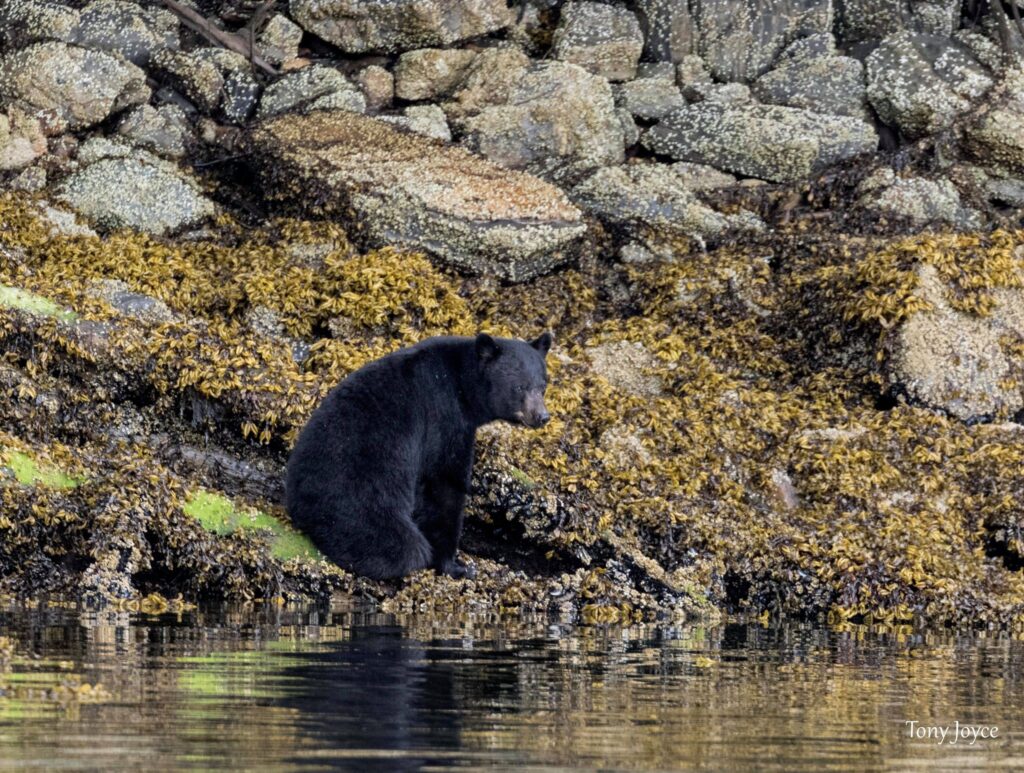
Colour Phases & Blazes
Despite their name, black bears in British Columbia may also have brown, cinnamon, blonde or white fur. Kermode bears, commonly referred to as Spirit Bears, are a rare subspecies of black bear found in the Great Bear Rainforest, British Columbia. Their fur can be white due to a recessive gene. Learn more about Spirit Bears: Pacific Wild ‘Great Bear Rainforest’ trailer. Spirit Bear cubs photo courtesy of Ian McAllister, Pacific Wild.
Black and dark brown with a tan nose are the most common colour phases on the North Shore. West Vancouver typically has more brown-phased black bears than North Vancouver. Cinnamon-phased black bears are rare here, but a few of our bears have this colouring.
Distinguishing marks such as chest and face blazes help us to identify individual bears. Many cubs are born with unique chest markings, but may lose them as they mature. If a cub’s mother has a chest blaze, it is likely her cubs will also retain their unique markings into adulthood.
BLACK BEAR CLAWS
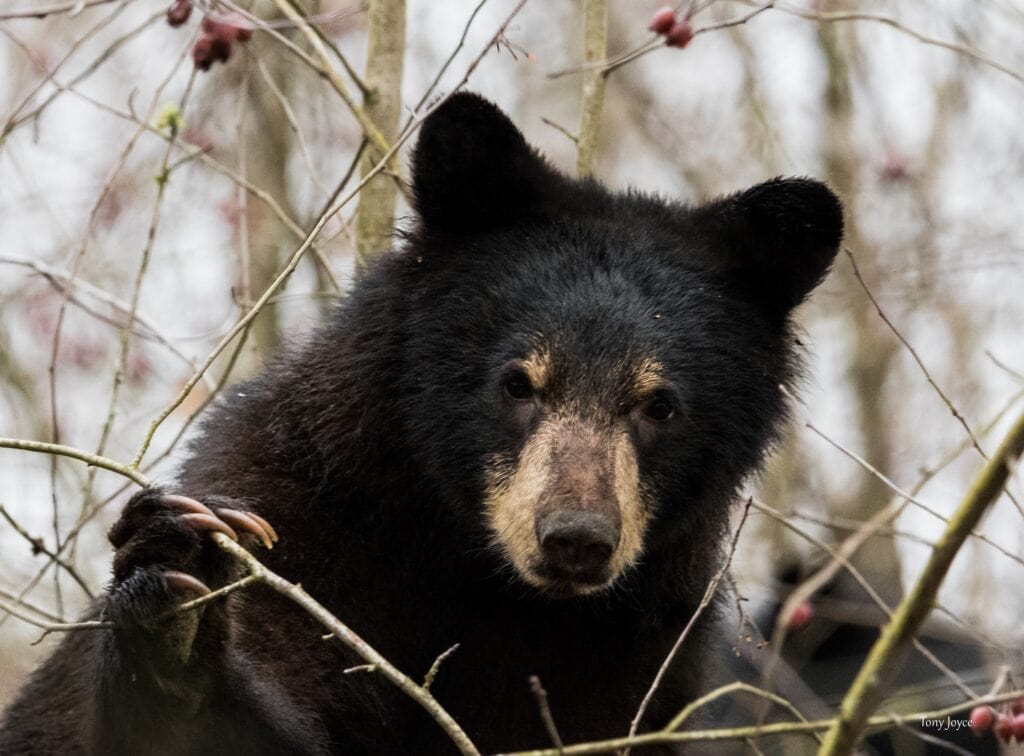
Black bear claws are for climbing, communicating and cultivating. Black bears have five short, curved claws on each paw, making them excellent tree climbers. Black bears spend time in trees to seek safety, access food and rest. Black bears use their sharp claws to mark trees. A bear will drag their claws down the tree trunk, leaving behind a visual mark and a scent. Bears communicate their presence to other bears using these scent markings.
Black bears also use their claws to dig for bugs, cultivating the soil as they do so. This allows air, nutrients and water to penetrate the soil. Black bears use their teeth and claws to rip apart logs in search of protein from insects and sugars from sap.
SCENT AND STANDING
With a nose over 2000 times more powerful than ours, a black bear’s sense of smell is unparalleled. Black bears are thought to have hearing and daytime vision comparable to humans, with the ability to see in colour and much better in the dark than we do, but they rely on their nose over other senses. Black bears often stand up like people – this is a curious posture which is often mistaken for aggression. A standing bear is lifting their head from the ground to acquire more information to help identify food sources, safe exits, other animals and humans. It is normal for bears to stand if they sense something close by, are surprised and even during an encounter.
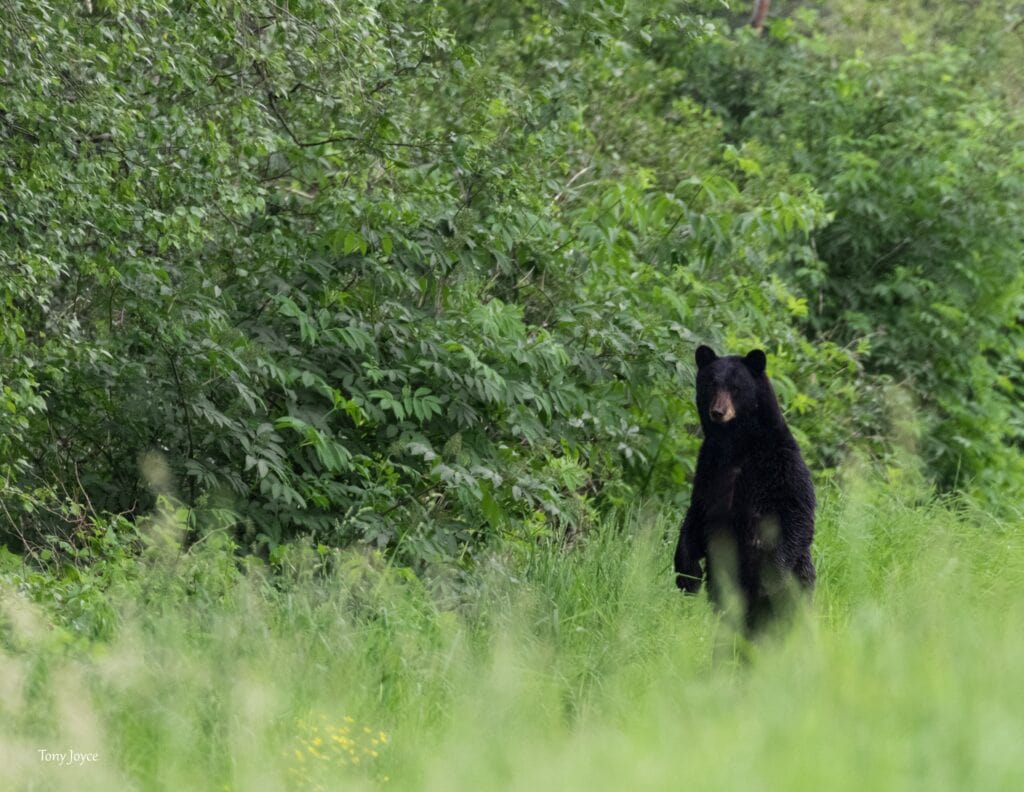
BLACK BEAR FAMILIES
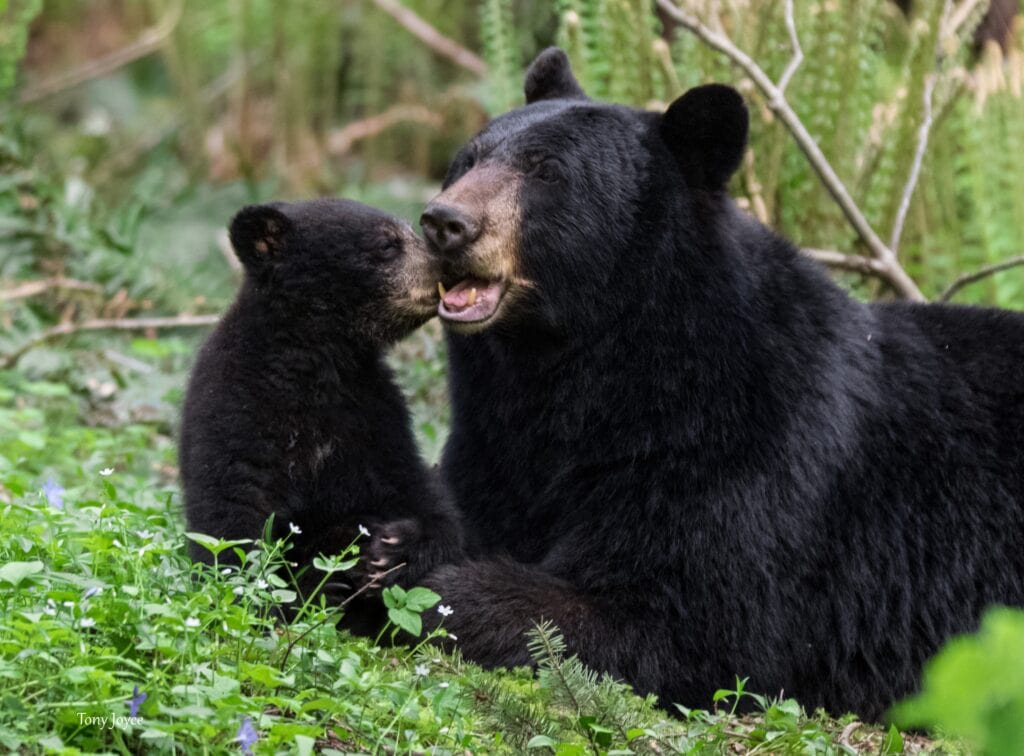
Mother black bears are the sole protectors, providers and teachers of cubs. Females who successfully mate in the summer and enter their winter den healthy, will give birth to cubs in late January. A healthy mother will generally give birth to more cubs. Typically, North Shore moms have 1-3 cubs and occasionally 4. Black bear cubs spend just 16 months with their mother before being dispersed to live independently. This means cubs have only a short amount of time to learn about seasonal foods and vital survival skills such as fishing. We should do all we can to allow bear families space and never intentionally interrupt this important time of teaching and learning.
One of the most common misconceptions about black bears is that a mother is aggressive and highly dangerous. In fact, female black bears with cubs are especially timid. A mother black bear is not a high safety risk to you, as long as you are respectful and not a threat to her family. It is exceptionally rare for a black bear mother to defend cubs, even during a close, surprise encounter. A mother black bear’s instinct is to avoid confrontation and send cubs to the safety of a tree. She protects her family by guarding the base of the tree. She may use vocalizations to communicate that she is stressed: this is how bears request space. If you ignore her request, she may take a step in your direction in an attempt to push you further away from her family. Black bears are intelligent animals who aim to avoid physical contact in an effort to avoid injury. Be prepared to deploy bear spray but expect a respectful encounter. Making intentional contact with a human is not in the nature of black bears but negative encounters do happen, though they are exceptionally rare. Taking steps to avoid surprising bears, knowing how to respond during an encounter and carrying bear spray will all contribute to further reducing risk.
If you encounter a bear family, communicate to them that you are not a danger by using a soft, calm tone to speak to them and by slowly moving yourself away to create distance. Remember that mother bears are often forced to occupy areas closer to people to keep their cubs safe from male bears. Cubs usually follow behind their mothers. If you see a bear crossing a trail or road, always be mindful that the bear could have cubs following them.
A mother black bear will not appreciate you getting close to her cubs – resist the temptation to approach them for a photo. This is also very stressful to cubs. We have witnessed people approaching families at close range, scaring cubs away from their mother. Be kind to all bears by giving them lots of personal space and respect. A photograph is not worth splitting apart a family or pushing bears into potential danger from vehicles or other bears.
If you see a lone cub, their mother may be close by but out of sight. Do not presume the cub has been abandoned. Black bear mothers may be scared away from an area, leaving their cubs at that moment, but they return to collect their family when it is safe. Never approach or attempt to feed or capture a cub. Report the sighting to Critter Care and NSBBS if on the North Shore.
SEASONAL HABITS
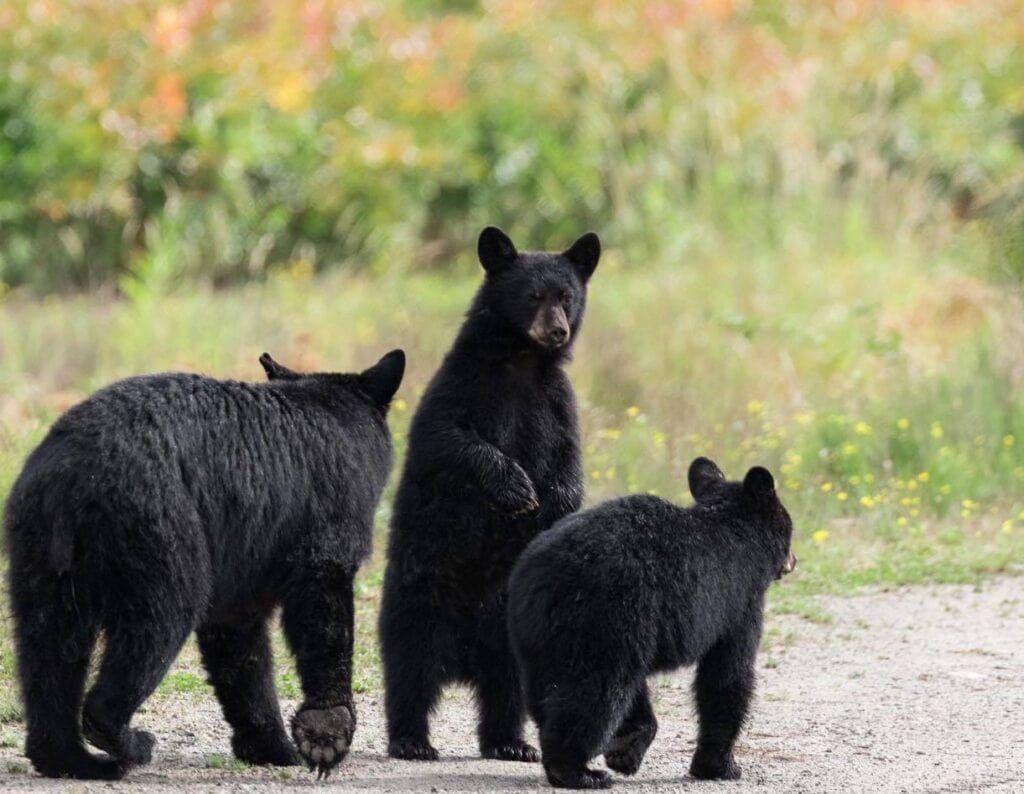
SPRING
Adult and juvenile North Shore bears typically emerge from their den as early as February. Young cubs born inside the den in late January will leave with their mother in late April. During this first stage of being awake from winter dormancy, and despite losing up to 30% of their body weight, bears are not as consumed by the need to find food as they were in the fall and they will be mostly seeking out fresh greens. However, given the opportunity, they will gladly eat your garbage and food scraps – which never ends well for bears.
Though their diet is 80% vegetation, black bears have the digestive system of a carnivore and seek to consume new growth, when young shoots are most nutritious and digestible. Grasses, sedges, dandelions and horsetail are important protein-rich foods that bears will graze on before berries arrive. During this time of low food availability, new cubs stay nourished thanks to their mother’s rich milk and adults rely on the fat reserves they built during hyperphagia the previous fall. Berries are a crucial food source for black bears and many other wild animals. Salmonberries are especially important, as they are the first berries to appear in our forests in late spring.
Foraging for spring greens brings bears to the roadside, where such food is plentiful. Be alert for all wildlife when driving. If you see a bear on the roadside, slow down and give the bear ample space – but please, do not stop. Approaching bears and turning off our engines contributes to bears feeling more comfortable around vehicles, greatly increasing their chances of being hit. Every year, bears are killed on North Shore roads.
Late spring is a sad time to be a teenage bear. Mother bears are the sole protectors of cubs until they reach 16 months of age, then one day in late May or early June, the young bears are pushed away to find their own home range and live independently of their mother. Mothers often allow their female young to stay close to the home they know, but males are pushed into unfamiliar areas. The dispersed yearlings do not want to leave her, they are often confused and frightened, making that known with heartbreaking whimpers and cries. Mothers reject the cubs’ efforts to remain with her and she is persistent in pushing them away. She does this to keep them safe from dominant male bears who will be seeking females as mating season approaches.
SUMMER
Bear sightings and encounters typically increase in the summer as more people spend time enjoying areas where bears live. During the summer months, new mothers are responsible for teaching cubs how to swim, forage and safely navigate life and fathering next year’s cubs is a focus for adult males. During mating season, which starts in the late spring and continues into mid-July, males travel extensively in search of females. Expect to see increased bear activity, as the pursuit of a partner brings dominant males closer to areas occupied by people. Mating pairs stay together for a short time during courtship before separating and living independently. It is normal to see mating pairs travelling through residential areas and they may spend time together in a quiet backyard for privacy.
Another summer focus is berries. Bears can eat thousands of berries each day, delicately picking them with gentle loose lips and long agile tongues. After bears eat berries, they disperse the seeds in their scat and assist in replenishing the forest. Please pick berries from residential areas to reduce bear attractants close to homes and leave berries in the forest for the animals that depend on them for survival. If you do pick berries, please harvest with wildlife in mind.
FALL
Contrary to popular belief, bears are not always hungry and they do much more than eat throughout the season. In the fall, however, the pressure to consume calories is what bears are focused on, after all, their survival depends on it. During this phase of hyperphagia (excessive eating and drinking) black bears can be active for 20 hours a day as they seek to consume as much food and water as possible.
Natural, seasonal food sources, such as salmon, can often be found in creeks and rivers close to residential areas. When we build homes in bear habitat and beside wildlife corridors, we should expect to see bears travelling through the neighbourhood to access these natural foods. In some cases, bears can be fishing just a few meters away from homes. The need to fish, forage and teach cubs during the fall, means bears have little choice but to be present where the high calorie salmon are spawning. It also means that bears who live on the periphery of urban areas can rarely afford to choose how far away from people they are.
The fat reserves that bears build in the fall are integral to their survival and they rely on these reserves well into the following spring. Mating season for bears takes place in the spring and summer months, but a fertilized egg will only develop if a female bear has gained enough weight during the fall period of excessive eating.
WINTER
Because few natural foods are available in winter, bears conserve their energy and enter a state of dormancy called torpor. Hyperphagia – the period of excessive eating and drinking in the fall – is to prepare for this long period without food. Bears can remain inside their dens without the need to drink, eat, or go to the bathroom for as long as six months.
Bears will spend months preparing their winter den, using their claws to create an entrance and chamber at the hollow base of a tree. They take time to select and drag materials from the forest floor to make a comfortable, warm bed in which to rest and restore over the winter.
Whilst inside their dens, black bears are in a light sleep. Each day, they stretch and groom to keep their muscles working – after all, there can be threats over the winter and the bear may need to respond quickly. A human, dog or another bear could enter the den and commonly in the late winter, the den can flood as the snow begins to melt.
The black bears we typically see around our communities and popular trails are the vulnerable population: females with cubs, juveniles, older and injured bears. Vulnerable bears may choose to den in green spaces close to our community, on our properties (very rare) or secure a den mere metres from busy trails in an effort to remain safe. If you suspect you have found a bear den, please let us know the location, and of course, please do not intentionally disturb any occupants.
BLACK BEAR DIET
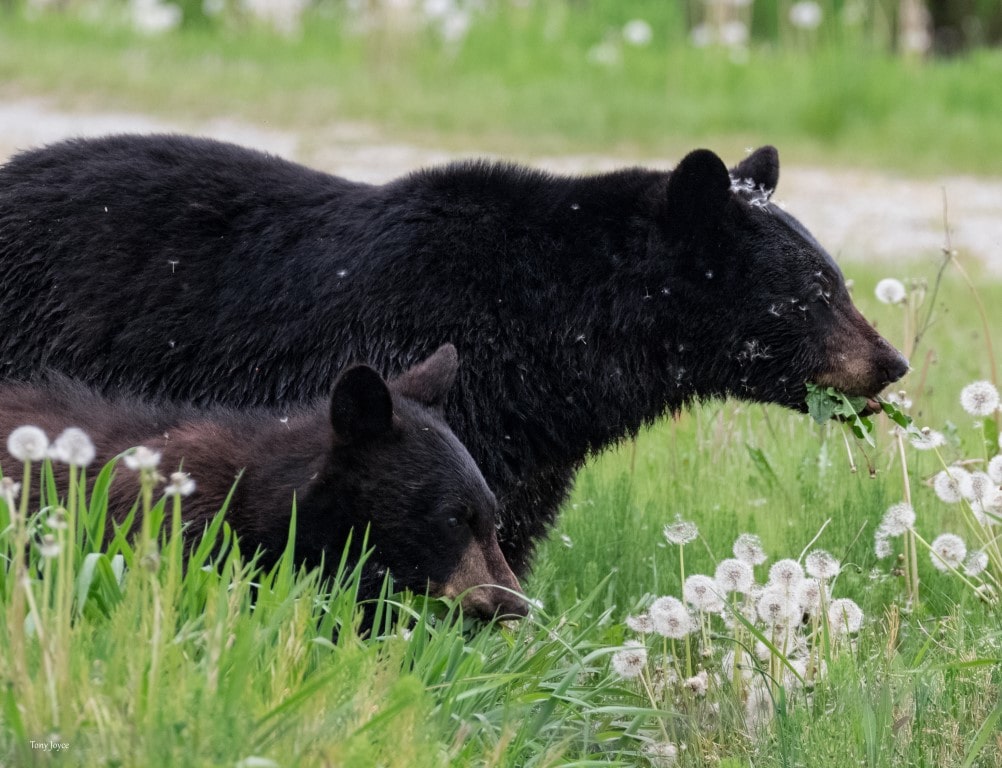
Black bears are omnivores and 80% of their diet is vegetation. The remainder is made up of animal protein found in insects, small mammals and occasionally large animals, such as deer. Bears browse and graze and may cache or claim dead wildlife. Be aware of bear foods and avoid areas with an abundance of natural food if you are not prepared to see a bear. If you find dead wildlife, ready your bear spray and calmly leave the area. Report your findings to the appropriate land owner and NSBBS.
It is important to allow bears space and time to eat, please never try to move a bear away from natural food in their home. Pushing bears away from berry bushes or fishing spots because we want to use the area is not respectful and can force them to seek opportunities in the community. One fall, we witnessed a bear family leave the salmon they had worked to catch because of pressure from people and dogs. A few days later, the mother and her cub were killed by BCCOS for finding unnatural food around homes.
If you encounter a bear that is eating, talk to them in a calm voice, slowly back away and leave the area. Bears may appear to be comfortable with your presence, but did you know that pretending to eat is one of a black bear’s subtle stress signals? Please respect bears by never intentionally approaching and always giving them lots of personal space.
BLACK BEAR SIGN
From marked trees to shredded logs, piles of scat and muddy tracks, clues that bears are using the area can be found all around us if we take the time to look. We encourage you to be present and aware of your surroundings as you move through areas where bears live. If you notice an abundance of fresh bear sign, avoid or leave the area.
NATURAL BLACK BEAR FOOD
SCAT
TRACKS & STOMPS
MARKED TREES
SHREDDED LOGS & DAYBEDS
THREATS TO BEARS
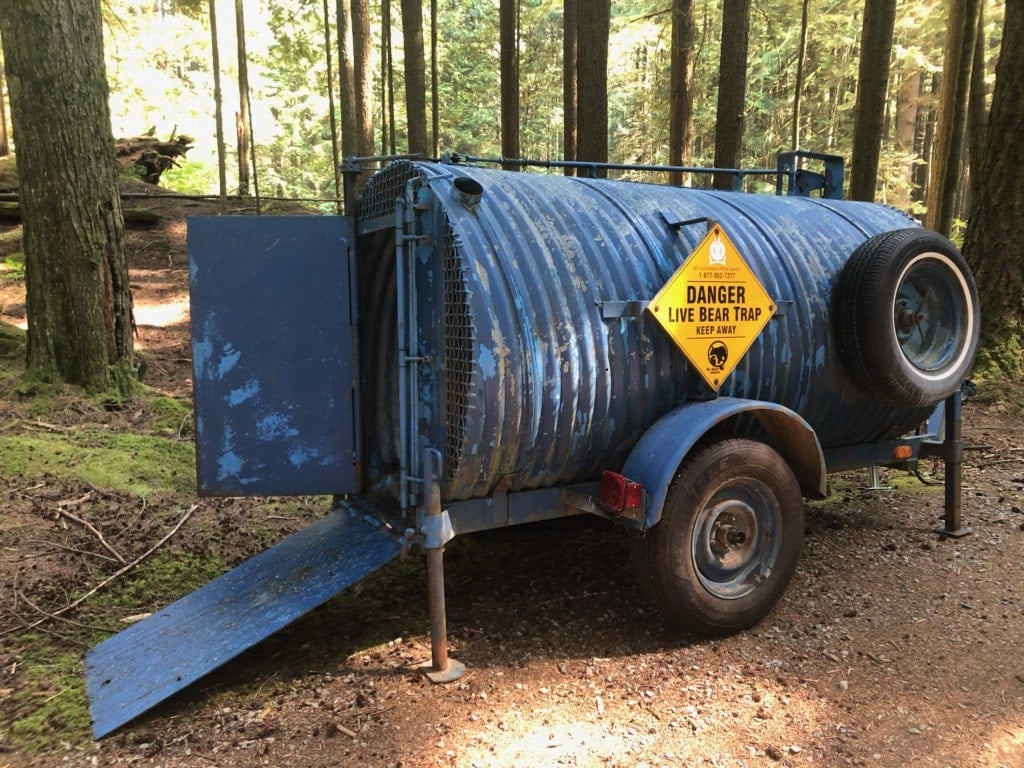
Bears and their homes are under constant pressure from development, industry and recreation. From vast developments to illegal trail systems, vital food sources and safe denning opportunities are being decreased, with remaining habitat under further pressure from climate change.
Every year in British Columbia, between 500 – 1000 black bears are killed by the BC Conservation Officer Service (BCCOS), the provincial agency tasked with managing wildlife. View the ‘Predator Conflicts and Statistic’ page for information on black bear, grizzly bear and cougar management statistics. The BCCOS follows the direction and policies of the Ministry of Forests, Lands, Natural Resource Operations and Rural Development.
NORTH SHORE BEARS KILLED BY BCCOS:
2024 – 2
2023 – 2 (In addition, four bears were euthanized due to old age, disease or vehicle strikes)
2022 – 5
2021 – 7 (In addition, one 5.5 month old cub orphaned by COS was abandoned in a residential area, COS euthanized an adult female after she was struck by a vehicle and a male bear was killed by vehicle strike. These 3 bears were living in West Vancouver)
2020 – 5
2019 – 13
2018 – 2
2017 – 18
2016 – 8
Most bears are killed for finding food around homes or for entering confined spaces, such as carports, sheds, garages, vehicles and homes. Non-lethal measures, such as relocation, are rarely an option and not a solution. Bears who have been reported to have found unnatural food, entered a confined space, made physical contact with a human or are described as aggressive are typically trapped or killed on site. The BC Conservation Officer Service sets baited metal traps in neighbourhoods, at campsites and on trails. If the ‘’target’’ bear is trapped, they are usually taken to another location to be killed. Sometimes snare traps will be set in forested areas. If you see a trap on the North Shore, please let us know so we can make efforts to share education with the community.
If you see a bear (or another animal) in a trap, contact the BCCOS 1-877-952-7277 immediately and also report to us. The NSBBS will make extra efforts to contact BCCOS to attend promptly. There have been incidences on the North Shore where bears were left in metal traps for extended periods during high temperatures. We will do all we can to reduce the bear’s suffering.
Please note that the NSBBS does not condone interfering with bear traps. Please keep your distance, whether empty or not. Never get close to a bear in a trap intentionally. Approaching a trapped bear adds further distress. If you have pets with you please leave the area immediately.
If you have a complaint about the conduct of an officer, the service provided by the Conservation Officer Service, or the policies guiding officers, please complete this complaint form
RELOCATION IS NOT AN OPTION
A common misconception is that black bears in British Columbia are relocated from human occupied areas and taken to the forest. For bears in BC this is rarely an option and it is not the solution. For example, in June 2021, BC Conservation Officers killed 75 black bears – one bear was relocated.
The NSBBS supports relocating bears in rare situations, such as the young Burnaby bear who took a wrong turn on the tracks and found himself in Gastown. Any kind of human intervention creates opportunities for bears to be injured or killed. Moving a bear away to an unfamiliar area is incredibly stressful; relocated bears often return to areas they know, can be killed by other wildlife occupying the area or struggle to find food. Very often when bears are killed in residential areas, within days another bear takes their place. Moving bears is not the solution. Bears are part of our wider community and we will always be neighbours. Learning more about their behaviour and acting on ways to reduce attracting bears to our homes, campsites and picnic tables is the solution.
TAGGED BEARS
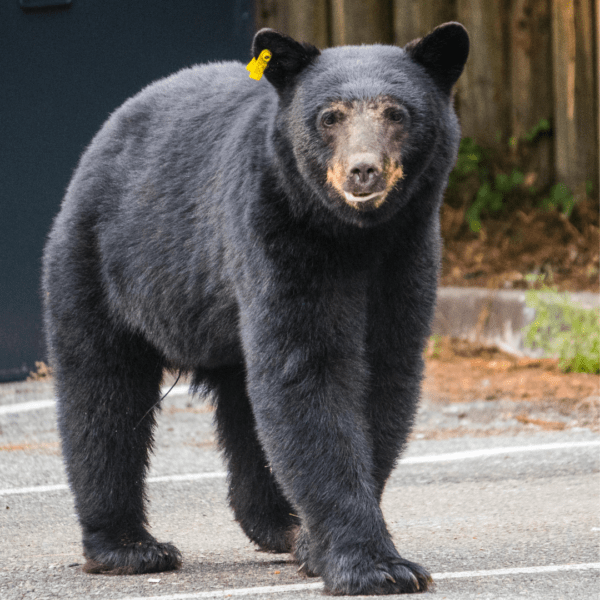
Very rarely, black bears may be relocated from a neighbourhood to a more suitable location within their home range, this could be as little as 2 kilometres from where they were found. Bears return to areas where they have found food and a short distance relocation only allows residents time to secure what was attracting the bear to their home. If the bear does not return to the area, within days other bears will fill the void if unnatural food sources are still available. A tagged, relocated bear would not receive another chance and would be killed if reported in the community again. Bears may also be tagged if they have been caught in a trap and are not the ”target” bear. Cubs who are taken to Critter Care will also be tagged. A tag does not indicate that a bear is aggressive, but rather that they have been handled by the BC Conservation Officer Service.
INJURED BEARS
Every year bears are injured and killed by vehicles on residential roads and highways on the North Shore. In 2020, two bears were killed by vehicles in West Vancouver and a young female bear was euthanized by BCCOS weeks after being injured by a vehicle. Sadly, no medical care is available to bears above one year of age in British Columbia. The current options are no intervention or death. Bears are incredibly resilient, they can survive and heal from serious injuries. The NSBBS is not aware of a single incident where an injured bear has made contact with a person on the North Shore. The best thing we can do for injured bears is understand that they may spend more time resting close to the community for safety during their time of healing, give them lots of personal space and ensure there is no food for them around your home.
NORTH SHORE BEARS KILLED BY VEHICLES:
2024 – 3 (suspected)
2023 – 1
2022 – 2
2021 – 3
2020 – 3
ORPHANED CUBS
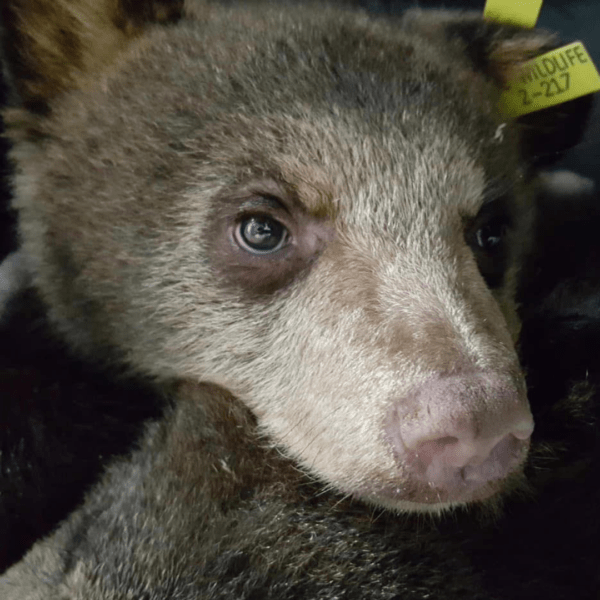
Currently, only black bear cubs who are injured or orphaned have access to medical treatment and rehabilitation in British Columbia. The cub must be less than one year old to be eligible. If a cub is orphaned when their mother is killed by BCCOS or a vehicle, or if they have been observed without their mother for some time, they may be taken to Critter Care Wildlife in Langley. The BCCOS follows direction from the Ministry of Forest, Lands, Natural Resource Operations and Rural Development (FLNRO) and are the only agency currently authorized to take North Shore cubs to Critter Care. If you observe a cub who you believe to be orphaned, contact Critter Care and the NSBBS immediately but do not make any efforts to corner or trap the cub yourself. If a cub is reported to the BCCOS for following their mother into a confined space (home, shed, garage) or for eating unnatural foods, they may also be killed.
Critter Care Wildlife is based in Langley and is the closest rehabilitation centre to the North Shore. Over the years, Critter Care has rehabilitated and released many cubs from the North Shore. Cubs are released as yearlings in the late spring, after the spring black bear hunting season has ended. Critter Care does not receive any government funding and is solely funded by donation. It costs up to $25,000 to care for one black bear cub. The centre also rehabilitates hundreds of native injured and orphaned wildlife each year. Please consider supporting Critter Care by donating, purchasing items from their wish list or volunteering for their internship for hands-on experience helping our local mammals. If you see injured or orphaned mammals, contact Critter Care immediately.
HUNTING & POACHING
The BC Government allows two legal hunting seasons each year during the spring and fall months. Inexperienced or careless hunters may orphan young cubs who are very small and stay well hidden, especially in the spring. These orphaned cubs contribute to the number of bears rehabilitated at Critter Care each year. The hunting of black bears is not permitted anywhere on the North Shore. Black bears are poached for their body parts. The bodies of poached bears are commonly found across British Columbia, including here on West Vancouver’s Cypress Mountain, July 2020. If you find the carcass of a bear, or any other dead wildlife, never approach. Bears and cougars often claim carcasses and hide them in the forest. They could feel pressured to defend their food if you surprise or approach them. Prepare bear spray and calmly leave the area. Report to BCCOS as soon as possible via the RAPP Line (Report All Poachers and Polluters) and the NSBBS.
AVOID SURPRISING A BEAR
Help to avoid suprise encounters by making noise with your voice. Whilst the sound of a bear bell is better than silence, it does not travel far or identify you as human. Talk to companions or wildlife as you travel through areas where bears live. Be slower and louder by water and in low visibility areas. This offers bears an opportunity to avoid you.
Be present and aware of your surroundings. Look for fresh bear sign such as scat, tracks, shredded logs and natural bear foods. Avoid or leave areas with an abundance of bear sign. Be sure to look up from your phone regularly and avoid wearing headphones.
Keep pets on leash. Off-leash dogs are involved in more than half of all recorded negative wildlife encounters. A dog may alert you to the presence of a bear, but they may also bring a bear to you. Off-leash dogs can pressure defensive behaviour from bears, especially if they chase them. Many of our North Shore bears are accustomed to encountering dogs and rarely run away. Under the BC Wildlife Act it is against the law to allow your dog to chase a bear. People, dogs, and bears could be injured or killed if you encourage or allow this to happen. Keeping pets on leash helps to reduce negative encounters and pressure on bears in their home. Pick up after your pooch. Bagged or not, dog waste attracts bears closer to trails, be sure to clean up and take it home with you or place in a bear-proof container.
If you see a bear ahead in the distance, calmly leave the area and take an alternate route. Be aware of your surroundings in all directions as you leave. Tell others in the area to do the same.
See ‘Exploring in Bear Country’ for more of the best practices for enjoying areas where bears live.
BEAR ENCOUNTERS
Expect to see bears on trails, crossing roads, passing through the neighbourhoods and even on the beach. Black bears are very active during the day and spend a great deal of time in human occupied areas without incident, however, living close to bears requires us to become familiar with how to respond if we meet one. By nature, black bears are peaceful, polite and in our experience, predictable. Here are some things to consider if you see one:
Stay calm
Talk to the bear in a calm voice (any language)
Slowly distance yourself and leave the area
If you encounter a bear try to remain as calm as possible. It helps to take a deep breath. Remember that black bears are calm animals, by staying calm you reduce startling the bear. Black bears are very intelligent and they recognize human voices and respond to tone. Communicate that you are not a danger by using a calm tone to speak to them in any language. Show the bear you are respectful of their personal space by slowly backing away. Calmly prepare your bear spray, but do not spray the bear unless they approach at close range with their focus on you. In most cases, when you start speaking in a calm tone to a black bear, they walk away, climb a tree for safety, or go back to eating or resting.
If you encounter a bear eating, calmly speak to the bear and slowly back away. If there is no alternate route, slowly and calmly create as much distance as possible, be patient and allow the bear to finish feeding and move on. Never try to move a bear away from a natural food source just because you want to take that trail.
BLACK BEARS ARE ADAPTING
Do not expect our North Shore bears to run from you or your dog. Bears are adapting to increased human and dog activity in their home, they aim to avoid close encounters, but running away wastes energy. In addition and contrary to popular belief – bears are not fearful. If bears were afraid of people or dogs they may feel pressured to defend themselves during an encounter. With increasing numbers of people and dogs enjoying areas where bears live on the North Shore, attempting to make bears afraid of us is not the solution. We do not want our bears to fear us, but we must make efforts to set boundaries and reduce encouraging bears to our homes with food.
GIVE BEARS LOTS OF PERSONAL SPACE
Don’t get close – never intentionally approach bears. It is very rare for black bears to make contact with humans, but they will not appreciate you encroaching on their personal space and you could pressure defensive behaviour. When bears are pressured by our presence, they show subtle stress signals such as excessive yawning, pretending to eat, moaning, huffing, salivating and jaw-popping. A black bear may take a step in your direction to request further space if you surprise them at close range or haven’t made efforts to give them space. Please do not misinterpret a bear’s stress signals as ”aggression”. Using that phrase to describe a bear almost always results with them being killed. During such encounters, we need to communicate to the bear through our tone and body language that we are not a threat. If you continue to pressure the bear by not calmly leaving, blocking the bear’s exit or using a harsh tone, the bear may feel forced to make contact. Such contact is rare and brief, typically resulting in minor human injury. If a bear makes contact with a human, even a curious tap, the encounter will be labelled as an ”attack” by BCCOS. A minor nip, bite or scratch from a bear that believes you to be a threat will get you injured and the bear killed. More commonly, if we purposely get close, we can push bears into the path of a vehicle or another bear who could be a danger to them.
BEARS ON YOUR PHONE MAY BE CLOSER THAN THEY APPEAR
If you encounter a bear, leave your phone alone and be present. Viewing bears through your phone can obscure how close they may be. During an encounter, be aware of your surroundings. Talk to bears in a calm voice as you slowly distance yourself. Using a calm tone and slowly moving away from bears communicates to them that you are respecting their personal space.
Approaching bears for photographs can pressure them to feel defensive. Bears may be comfortable with people at a distance, but the boundaries of personal space are unique to each individual. Never approach a bear intentionally.
Getting close to bears on purpose disturbs their natural behaviour and adds further stress to their daily life. Our actions around bears have a huge impact on their lives. We can interrupt valuable teaching opportunities between moms and cubs or force bears away from natural food sources. Being too close can pressure bears to flee into the path of a vehicle, or another bear who could be a danger to them.
Bears are not here for our entertainment. Never attempt to take a selfie with a bear. If you’d like a close up photo with a bear, visit our educational display and pose with Ted, our life size bear cut out!
IF A BLACK BEAR APPROACHES
On occasion, bears may appear to approach us. Bears can be pushed towards us by other bears, people or they simply may wish to take the path that you are on. On these occasions, the bear will not be focused on you and we should calmly speak to them as we slowly distance ourselves and allow them to pass.
Very occasionally, bears may approach us with intent, this is usually out of curiosity. It is important that we set boundaries and do not allow bears to enter our personal space. If a bear is quietly approaching with their focus on you, stand your ground and use a firm voice – tell the bear they are too close. Be persistent in using a firm tone and prepare your bear spray. If a black bear continues their approach, deploy bear spray. If you do not have bear spray and a black bear makes intentional physical contact, fight back with all you have, aiming for their eyes and nose.
We should always have bear spray accessible when enjoying bear habitat. On rare occasions when our voice is not enough to deter an approaching bear or if we surprise a bear at close range, we may need to deploy bear spray. Bear spray is a non-lethal tool which can be used to teach bears boundaries and it could save your life in the exceptionally rare case of a negative encounter.
Help us to collect valuable data and target education by reporting all North Shore bear activity to us.
